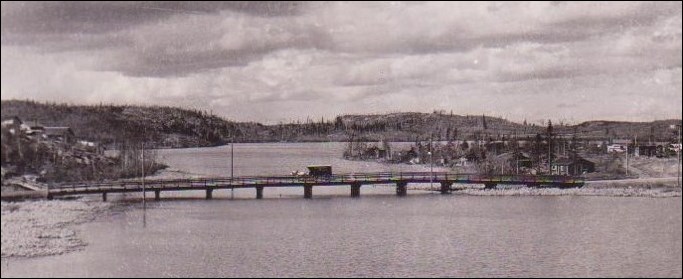This month, I offer a few random recollections of interesting aspects of life in Flin Flon.
Ross Lake Island: The feature photo this month illustrates that Ross Lake Island was once really an island. It was connected to the Ross Lake subdivision by a rather elaborate wooden traffic/pedestrian bridge. A causeway with culverts was built from the east side of the island to the shore at Mile 84. The bridge in the photo was eventually shortened and then removed.
Did you know? When Channing Road was being paved back in the early 1950s, the Saskatchewan government at first refused to pay for paving the small section of the road that passed through Saskatchewan? They were eventually embarrassed into doing so.
Unique! The Manitoba/Saskatchewan border has created all sorts of unique situations, including the recent decision to have the Creighton RCMP respond to calls from Flin Flon, Sask. As it is, the border can be crossed by road at the end of Main Street, on South Hudson north of Eddies, at the Centoba Ball Diamond, and twice on Channing Road. Signs at the South Hudson crossing such as, “You are now leaving Flin Flon, Manitoba” and “You are now entering Flin Flon, Saskatchewan” and vice versa would make great tourist selfie photo opportunities.
Nicknames: Back in the day, many men and some women had nicknames. If a man had red hair, he was called “Red.” A tall, thin man was called “Slim” (Holdiway). A short man, “Shorty” (Russick). A heavy set man could carry the name “Tiny” or “Spud.” A well-known Flin Flonner, “Bud” Jobin’s first name was actually Francis. Henry was “Hank.” William was “Bill,” Charles was “Chuck.
Ethnicity came into play as well. A man from the Netherlands was called “Dutch.” A Swedish man, “Ole;” an Irishman, “Paddy” (O’Houlihan) and a Scot, “Jock” (Duffner).
Some men were given names that referred to their trade – or some infamous incident that occurred at work. Some nicknames of that era could now be considered “politically incorrect,” but I don’t think any offence was intended. On the distaff side, let us not forget Min “Mitzi” Stein and Rachel “Buckie” Dodds!
Quick quiz: What was the Modern Dairies advertising slogan?
Curfew: I recall the town council declaring a curfew sometime in the late 1940s. The town fire siren would sound at 8:50 p.m. as a warning and then give a long howl at 9 p.m. All children (under the age of 16, I think) were required to be indoors. I can’t remember the penalty for being “caught out” but no doubt our active young minds created all kinds of cruel and fearful punishments.
Graveyard: It was a common term that did not refer to a cemetery. “You kids go play somewhere else. My husband is on graveyard shift.” Or, “Hey guys, we can’t play at my place because my dad is on graveyard,” that being the midnight to 8 a.m. shift at the mine that required sleeping during the day.
Why call it Church Street? It was so named due to the number of churches on that street. Early churches: St. Augustine’s, later St. Ann’s, Roman Catholic, the Salvation Army, Northminster Memorial United (previous location now the former Labour Temple), St. James Anglican, and St. George’s Ukrainian Greek Orthodox (built 1952). The now St. Peter and St. James Anglican and the Ukrainian Greek Orthodox churches are the only ones still functioning at their original locations.
Did you know? The original RCMP detachment was located in the Flin Flon municipal building at the corner of Third Avenue and Main Street. The detachment moved across the street to the second floor of the new post office in the early 1950s. A suite for the commanding officer was located at the southwest corner. The detachment is now located in the Flin Flon Fire Hall building. The area occupied by the present post office was previously a vacant lot.
Bonus! At one time, an RCMP constable was assigned to do an evening door check of all businesses on Main Street – occasionally finding an unlocked door.
Quiz answer: “You can beat our cream but you can’t beat our milk!”
N.B. Most of what you’ve read is the product of my naturally fallible memory. Any corrections or comments are welcomed.
Got any comments or reflections on this column? Contact Vincent at [email protected].




